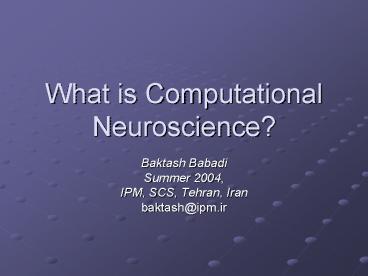What is Computational Neuroscience - PowerPoint PPT Presentation
1 / 25
Title:
What is Computational Neuroscience
Description:
Computational neuroscience is explaining and analysing the ... Link to Ising model. Rumelhardt, Mc (1986) PDP. Multilayered perceptrons. Sejnowsky (1989) ... – PowerPoint PPT presentation
Number of Views:292
Avg rating:3.0/5.0
Title: What is Computational Neuroscience
1
What is Computational Neuroscience?
- Baktash Babadi
- Summer 2004,
- IPM, SCS, Tehran, Iran
- baktash_at_ipm.ir
2
Computational neuroscience is explaining and
analysing the nervous system by means of
mathematical tools
3
How to tackle the Brain?
Modeling/ Mathematical analysis
Psychophysics/ Behavior
Physiology/ Wet Lab
4
Why mathematics?
- An example from the history of physics
Tycho Brahe
Johannes Kepler
Isaac Newton
Mathematical model
Observation
Regularities
5
Why Nervous System?
- Complexity of nervous system
- Matter of interest for computer scientists
- The mystery of mind!
- Need of contemporary capitalism/industry
6
?
7
The History of Theoretical Neuroscience (1)
Ancient Greece
- Hippocrates
- Epilepsy
- Plato
- Sphere!
8
The History of Theoretical Neuroscience (2)
Modern Ages
- Descartes (1596-1650)
- Leibniz (1646-1716)
9
The History of Theoretical Neuroscience (3)
- Galvani (1737-1798)
- Excitability
10
The History of Theoretical Neuroscience (4)
- Helmholtz (1821-1894)
- Velocity of nerve impulse -gt Anti Vitalism
- Frequency coding in inner ear
11
The History of Theoretical Neuroscience (5)
- Golgi (1843-1926) -gtStaining
- Ramon Cajal (1852-1934) -gtNeural Doctrine
12
The History of Theoretical Neuroscience (6)
- Lapique (1907)
- Integrate Fire model
- Adrian (1926)
- Neural recording
13
The History of Theoretical Neuroscience (7)
- Hebb (1949)
- Neural Populations
- Plasticity
- Hubel Wiesel (1959)
- Receptive Field
- Early visual processing
14
The History of Theoretical Neuroscience (8)
- Von Neumann (1947)
- Artificial Automata-gt Cellular Automata
- Artificial Life
- Parallel Processing
15
The History of Theoretical Neuroscience (9)
- Rosenblatt (1958)
- Simple Perceptron
- Minskey Pappert (1968)
- Linear separability
16
The History of Theoretical Neuroscience (10)
- Hodgkin Huxley (1952)
- Theory of action potential generation
- Roll (1960-1970)
- Cable theory
- Fitzhugh Nagumo (1969)
- Analysis of excitability
17
The History of Theoretical Neuroscience (11)
- Hopfield (1982)
- Link to Ising model
- Rumelhardt, Mc (1986)
- PDP
- Multilayered perceptrons
- Sejnowsky (1989)
- Nettalk
- Amitt (1991)
- Attractor neural networks
18
The History of Theoretical Neuroscience (12)
- Connectionism
- Large-scale computer simulations
- Brain as a complex dynamical system
19
The History of Theoretical Neuroscience (13)
- David Marr (1945-1980)
- A theory of cerebellar cortex (1969)
- A theory for cerebral neocortex (1970)
- Vision (1982)
20
Levels of Computational Brain Research (David
Marr)
- Theoretical Level
- Algorithmic Level
- Structural Level
21
Levels of Neural Modeling
- Brain as a whole
- Specific brain systems (visual system,)
- Large scale neural networks
- Small neural networks
- Neurons
- Ion channels and synapses
- Molecular processes
22
Methods in Neural Modeling
- Analytical Solutions
- Numerical/Computer Simulation
23
Approaches in Neural Modelling
Poggio, PDP, Edelman, Grossberg
Amitt, Sompolinsky van Wreesvijk, Treves, Hertz,
Hopfield
Population
Bressloff
Abbott, Sejnowsky, Aertsen, Gerstner,
Bienenstock, Koch,
Level
Ermentrout Koppel
Rinzel, Termann, Izhikevich
Destexhe
De Schutter
Single cell
Analytical
Simulation
Method
24
Course Outline
Ionic Channels and Experimental Methods
Differential Equations/ Dynamical Systems
Hodgkin-Huxley Model of Action Potential
Cable theory of Dendritic Transmission
Simplified models of Neurons
Neuron Simulation Environment
Characterizing the neural response
Information Theory
Rate Coding/Temporal Coding
Small Neural Networks
Plasticity and Learning
Large Neural Networks
Computational Neuroanatomy of Cortex
Models of Early Visual System
Models of Higher Visual System
25
References
- Spiking Neural Models, Gerstner Kempter (2003)
- Theoretical Neuroscience, Dayan Abbott (2001)
- Methods in Neural Modelling, Koch Segev (1998)
- Neuroscience a mathematical primer, Scott (2002)
- Spikes, Exploring the neural code, Rieke (1997)
- Corticonics, Abeles (1991)
- Biophysics of Computation, Koch (1999)































